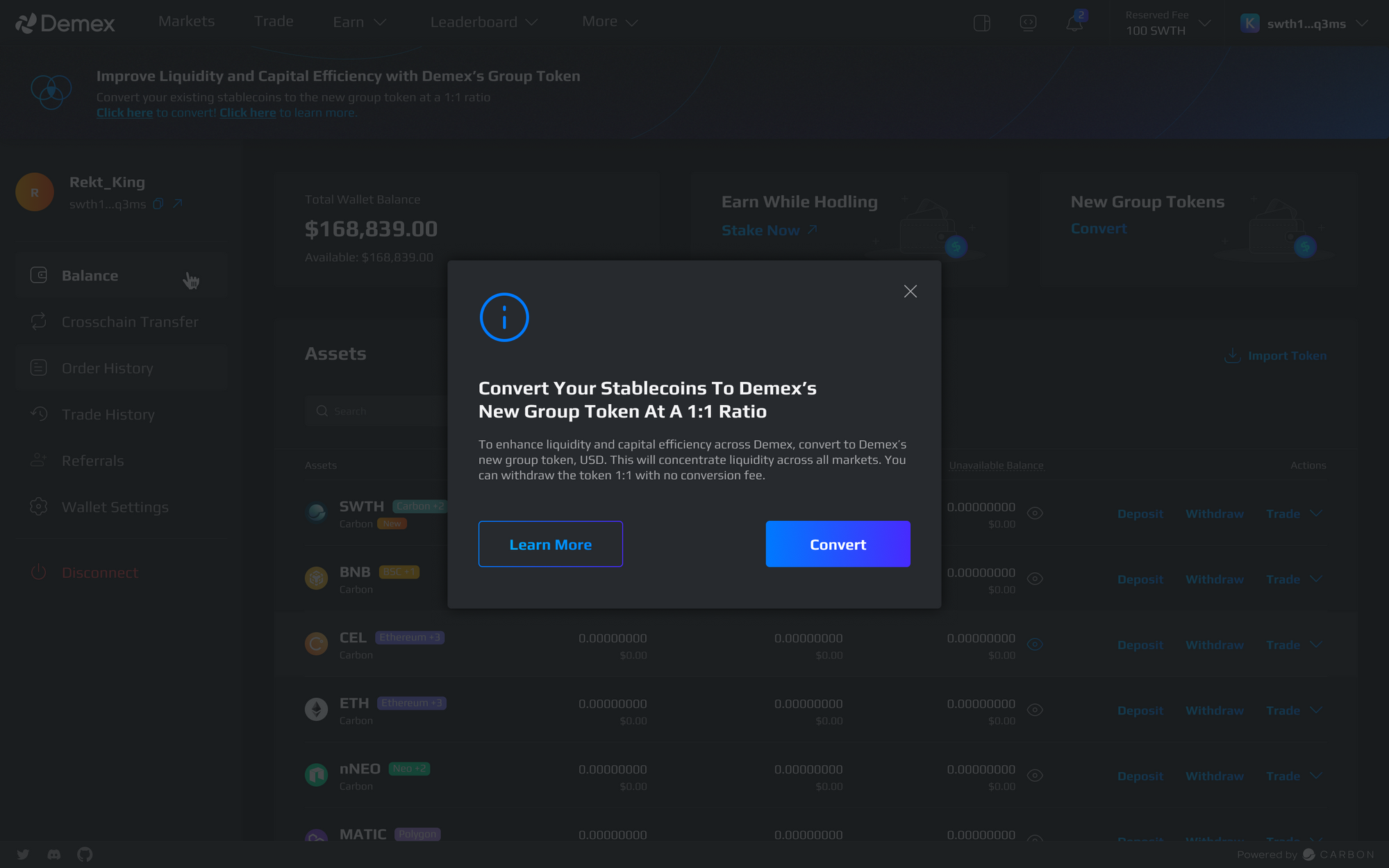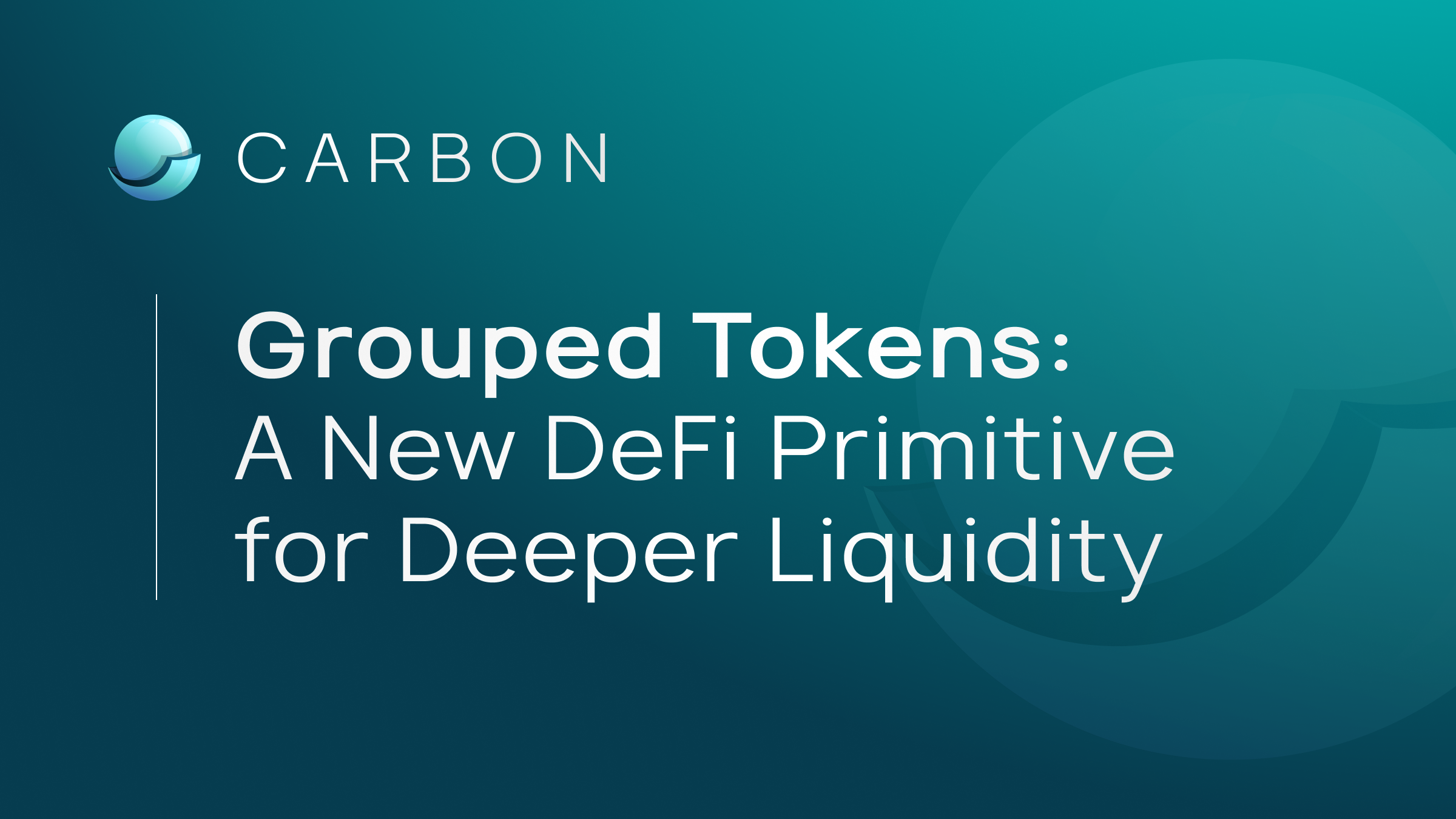Grouped Tokens are a new DeFi primitive that allow different tokens with the same value to be grouped together into one fungible token, in order to provide deeper liquidity and a more seamless user experience.
As more bridging solutions appear, and more stablecoins arrive into crypto, liquidity becomes fragmented. For instance, axlUSDC from Axelar, is effectively the same value as axlUSDC from Osmosis, which has the same value as USDC from Ethereum, which as the same value as BUSD from Ethereum, as they are all redeemable for $1. However, because they come from different chains or channels, the liquidity is non-fungible in an AMM pool or orderbook, fragmenting liquidity between the different stablecoins.
Grouped Tokens can extend beyond stablecoins, and even include non-stablecoins such as different types of ETH from various bridging solutions.
This feature will be the first time it appears in DeFi, and it is launched by Switcheo Labs, a web3 development lab that built the cutting edge Carbon network which supports all kinds of financial instruments.
Benefits of Grouped Tokens
Attracts More Users
Right now, the dominant stablecoin in Cosmos is axlUSDC, however, axlUSDC from different IBC channels is non-fungible.
This means that directly sending axlUSDC from Kujira, or Osmosis, or Terra to Demex, will all result in a different axlUSDC.
To solve this, users need to send their axlUSDC to Axelar first and then to Carbon so that all axlUSDC uses the same channel ID. This is a huge hassle and disrupts the onboarding experience when we integrate assets from new IBC chains.
With Grouped Tokens, when we launch a new perp, i.e. KUJI-perp or LUNA-perp, users from those communities can simply send axlUSDC directly to Demex, and it will simply be 'USD', which they can use as margin right away to trade perps.
Deeper Liquidity
As mentioned previously, by consolidating similarly valued tokens into one, liquidity of certain pools will be deeper.
This would remove the need for multiple stablecoin pools such as USDC/BUSD, axlUSDC/USDC, and more, as they will all be simply "USD" on the platform.

This means that pairs that are connected to different stablecoins such as SWTH/BUSD and SWTH/USDC will be consolidated into simply SWTH/USD which would deepen the liquidity.
At the moment, consolidating these two pools will double the depth of SWTH.

Seamless Trading Experience
Currently when depositing stablecoins into Demex to trade to a particular asset, a user may need to change their stablecoin into the right stablecoin for that particular market, creating a disjointed experience.
With Grouped Tokens, users will not face this issue as existing markets with stablecoins will switch to being paired with fully fungible USD.
Used as Cross-margin for Perps
Currently, you can only use Ethereum's USDC to trade perps on Demex. This will be replaced by the USD Grouped Token.
Bridging USDC from ETH incurs high gas fee and depositing USDC or BUSD from BSC is cheaper and faster, as they will all be converted into the USD Grouped Token on Demex.
Cross-margin trading allows users to use multiple assets as margin to trade perps. In the future, when Demex enables cross-margin, users can use ETH as margin for trading perps, and ETH can be part of Grouped Tokens as well regardless of which chain the ETH comes from, be it Arbitrum, Avalanche, or others.
How do Grouped Tokens work?
For deposits:
When users deposit any of the whitelisted tokens on Carbon Demex, it will be grouped into a single token that represents those whitelisted tokens.

Using USD Grouped Tokens as an example, this means that a selection of U.S. dollar (USD) stablecoins that are fully backed can be minted into a single “USD” group token.
For example, when a user deposits USDC from Ethereum or BUSD from Binance chain into Demex, it will be shown as USD.
Note: When Grouped Tokens are live, there will be no change to any existing stablecoins or markets. They will remain as it is but will be encouraged to convert their stablecoins into USD and migrate their liquidity to the new USD markets. However future stablecoin deposits will automatically be converted into USD.

For withdrawals:
Users can select their preferred stablecoin to withdraw followed by the available networks for that stablecoin.
The available withdrawal amount will be shown and if there are not enough liquidity for withdrawal, a user might need to deposit to other chains or wait for the pool to be rebalanced.
Anyone can rebalance the stablecoins pools but validators/team have an alert system and will be notified whenever a pool is running low and can help to refill that stablecoin pool.
How to Rebalance Grouped Tokens:
Using the example of stablecoins:
- If there are lots of withdrawals to USDC Ethereum, the USDC balance will run low or be emptied.
- Anyone can deposit USDC Ethereum to Carbon to refill the balance, and withdraw USDC to another chain which has more availability, i.e. BSC.
- They would then bridge USDC from BSC to Ethereum, and repeat the process until pools are balanced.
Who would rebalance the Grouped Tokens?
In the beginning, there will be no incentives given to rebalance the pools, so who would rebalance the pools?
The Carbon team as well as other rich entities with vested interests will use their liquidity to ensure sufficient stablecoins of each type to withdraw.
Although it is not free, it is not expensive to rebalance. I.e. it costs a flat gas fee (probably less than $20) each time to rebalance, even if it is rebalancing millions of stablecoins, or other assets in the future.
This is considered a small price to pay to be the first to launch this attractive feature that will improve the onboarding experience and bring more users from various ecosystems over to Demex to trade.
This is similar to what Binance does with their auto conversion of USDC to BUSD.
Later on, incentives can be added to make the process more decentralized and community-driven.
How we mitigate risks for Grouped Token:
Stablecoins Depegging
What happens if a stablecoin that is listed gets depegged?
This is very dangerous and will potentially ruin the value of the whole pool if any one of the stablecoin depegs to $0.
That's why we only list stablecoins we can actually redeem in real life (like USDC) or are super confident in the peg (hence for now no USDT ). On top of this, we have some security measures in place.
Stablecoin Depeg Detector:
The moment our oracle detects one of the stablecoins is getting depegged, it will auto pause deposits for that stablecoin.
Binance, Paxos and Circles Accounts for Arbitrage:
BUSD in Binance can be withdrawn as USDC 1:1. Additionally, BUSD and USDC can also be redeemed 1:1 into USD in a bank account via Circle and Paxos, and vice versa. This will help with irrational and temporary depegging scenarios, as long as the redemption mechanism continues to function.
Rate Limiters:
In the future there can be a rate limiter feature where if a large amount of withdrawal is detected, the withdrawal may be paused and validators can take a look to manually ensure everything is okay.
More security features will be built as we continue to develop this feature.
Initial tokens to be added to USD Group:
- USDC from ETH and BSC chains
- BUSD from ETH and BSC chains
- axlUSDC from Axelar, Osmosis, Kujira, Terra chains

For more information about Grouped Tokens, visit our docs here.
Future Grouped Tokens
BTC and ETH will be popular choices.
For BTC, there's already quite a few of them in existence:
- wBTC on Ethereum (nobody likes paying ETH gas)
- wBTC on BSC
- BTC.b by Avalanche
- Nomic also has a decentralized native bridge for BTC on Cosmos
- Thorchain might launch syn.BTC on Osmosis as well
- Not to mention axlwBTC is probably a thing
So there's at least 6 different BTCs today, but probably lots more in the future and Grouped Tokens will help streamline this friction on Demex.
Conclusion
The Carbon network allows for the creation of any kind of financial instruments, and the creation of Grouped Tokens are just one of the many fascinating financial instruments that will be launching soon.
Grouped Tokens will improve the liquidity and simplify the trading experience for users on Demex, two things that are greatly needed to improve the platform.
It's easy to see how Grouped Tokens improves liquidity and user experience, but it is important to balance between the risks and benefits and the Carbon team will be paying close attention to this feature at launch.
The grand vision of Demex exchange is to be a complete alternative to CEX. By autoconverting different USDC and BUSD into simply USD, it allows for deeper liquidity, and stablecoins is just the start as there will be more pegged tokens coming to DeFi.
Demex is the non-custodial platform for users looking for a frictionless trading experience that rivals CEXs.






